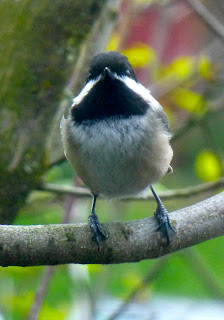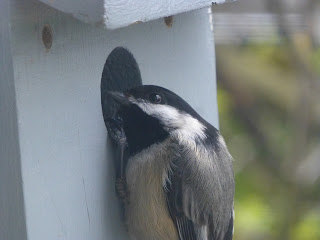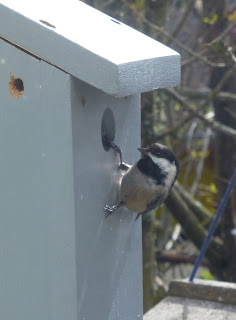I looked online to find out how to tell chickadees apart. A few sites suggested that the males have a bit more contrast between their white and black patches than the females. Myself, I would have thought that black-and-white is pretty much the gold standard for contrast already, but then again I have a closet full of black clothes that don’t match each other, so maybe there’s something to it. The problem with this method of chickadetermining is that it works unless it doesn’t. Nobody seems to be real confident about it, and it may have been made up by someone with intermittent astigmatism.
I am further informed that the male sings to the female for several weeks to get her in the mood, but he mainly does it at daybreak, which does not intersect with any of my periods of consciousness. Supposedly, the female is the one that makes up the mattress in the nesting box. I’m thinking the researchers are flying blind here, and the only really good way to tell who’s the female is to see who drops an egg. Or, conceivably, who is on top during the two-second sex act the male has been singing his heart out for. On many animals, the male has a little tag hanging down with his identity on it, but not in chickadees. Both male and female have a cloaca, an all-purpose vent, and during the sex act the birds get close enough to swap schmutz from their cloacas, although even then I would think who gets to be on top might well be a matter of
personal preference and not really any business of ours, or the state’s.
Ducks do have something like penises, quite impressive ones really, fashioned from an exuberant portion of their cloacas and powered by lymph instead of blood. Evolutionarily speaking, the reason they have developed such an item is to ensure that their contribution to the gene pool gets inside the female rather than washing out in the pond, because walking barefoot in a duck pond is revolting enough already.
I still maintain that we can’t know anything for sure until the egg comes out, and at that point researchers, if they want to know who does what, should make them little hats. I have decided to go
with my gut as usual and figure it out from what I’ve observed. So far, there has been no furniture moving in the house, but quite a lot of inspection. One of the birds darts straight in and stays a while, and the other one prefers to hang by one claw from the doorhole and inspect the roof. I think the female is inside, deciding where the piano goes, and the male is outside, trying to see if the structure is strong
enough for a piano. Call me sexist, but that’s how it works in our house. In our house, the male has a nice contrasty head and the female doesn’t even have eyebrows. And the male does all the cooking and most of the laundry and the female does–well, we’ll have to do a few more years of observation to figure out what the female does. Anyway, here in our house, the female got her heart set on a big-ass piano, and the male checked out the bearing walls and got a bunch of studs and whacked a wall apart so it would fit, wondering audibly why the female couldn’t have taken up clarinet.
In general, the literature recommends keeping one’s distance from the observed birds so as not to disturb their mating rituals or cause them undue stress. Admittedly, I am only a few feet away, but I am not concerned. There is nothing less disturbing than a nearby writer. Most of the time, she doesn’t move at all.



I tried very, very earnestly to observe some birds when I was little. I frightened them away with all my wriggling around. I grew up to become a sort-of writer with considerably reduced wriggling.Still haven't observed much.
But I did see bees mating and not many folk can claim that!
I'd give you points for bees, for sure. And you're my kind of writer if you've reduced your wriggling to "indetectable," even down to the fingertips.
OK, now that you are absolutely no help in sexing chickadees, how about moving on to the titmouse. But I love that you love the little fellows. The Carolina wren is my favorite. Come to think of it, how about delving into how to tell them apart first.
No can do. I can tell them from chickadees. Carolina wren, cute cute cute. We don't get to have any here.
While sitting in my garden one afternoon a wren landed on my head and tugged and tugged until he plucked out a hair. It was all I could do to sit still I was laughing so hard.
I think the answer to your puzzle is buried there in your post…the male is the one singing away in the budding tree. The female is the one hiding where you can't see her.
That's if you believe the female-makes-the-mattress bit and the male-sings bit but I still say that until you've seen the egg drop, those researchers are just guessing.
Do you think the chickadees can tell the difference?
Nope.
Hmmm. A useful post – gives me many more reasons why I'm glad I'm not a bird. Birds are much more photogenic than I am, though, so there is that…
[Apply Oprah voice] If you were a bird, what kind of bird would you be?
Probably a sandhill crane – a long-legged, loud redhead. But don't get in the way of that beak.
I wish I'd written that last paragraph.
Which actually just keeps getting funnier the more I think about it.
Like so many birdies that have come before us, the duties in my home are determined by sex as well, mostly by who is ready to give it rather than tackle whatever chore has come up…
Pearl
So something, or someone, is always being done. Excellent.
This comment has been removed by the author.
Now your chickamate has me worrying. We're hoping to move at some point in the not too distant future and there's a piano coming with us. It never would have occurred to me to consider whether or not a place could handle its weight.
Schmutz swapping made me laugh out loud.
In our case, the house couldn't handle its length.
Highly entertaining cute overload 🙂
Yeah, they're here all year, and I ALMOST get sick of them, but never quite.
Oops, I see that might have been misinterpreted. To be clear: I LIKE cute. Cute overload is fine with me 🙂
No, I got that!
Oi! Brewster!
"I think the female is inside, deciding where the piano goes, and the male is outside, trying to see if the structure is strong enough for a piano."
My sprayed coffee curses you, madam.
Roth
I too remember deciding that black would work a treat in finally having all my clothes match. You're right that it doesn't but now I'm too old to care if I'm wearing red-black with green or blue-black. Then there's all the shades of gray the 'natural' fibres become with age. I tell myself I'm wearing midnight rainbow shades.
I sympathize with your chickadees and their mating and moving dilemmas. We've moved a lot too and the male in this family always complains the furniture belongs to the female.
I'm starting to think I should just get multi-colored clothes the color of all my food.
"swap schmutz from their cloacas." This line is so good it deserves a photo of the Carolina wrens nesting in my CSA veggie box. I was trying to get an angle on her today- she's chosen the oddest spot for her nest and it was cloudy and blustery today- but I plan to put on my Wellies and go after the shot first thing in the morning. Watch for it- I'll dedicate it to you.
I would LOVE that. They're even cuter than chickadees, and we don't have any.
Well, I like the disgusting duckpond line best. And thank you for that detail that duckdick is powered by lymph instead of blood. If I ever knew that I had forgotten it, and it's bound to come up in conversation soon, so thank you.
xoxox jz
"Come up in conversation!" Ar ar ar! Gee, I hope I was right. [scurrying off to Google now]
Okay I'm back. Yes, lymph. And it results in an "explosive erection."
"Swapping schmutz" is known as cloacal kissing among bird sex aficionados.
That is true. But a little too mushy for me.
Incidentally, are you saying you can speak for bird sex aficionados?
I can, and I do.
Murr, I think you should check your stats for "kinky bird sex" searches!
I still haven't finished wiping up from the doggie sex toy post.
Loud face hurting smiles from yet another of your posts. And I learned things as well. Bonus.
I'm all about the education.
Walking in duck ponds is revolting, even with boots on. Once they dry (the boots, that is) the gunk is glued on, and you have to reconstitute it to get it off.
And now I'll be squicked out by amorous chickadees, too. Ma Nature is perilous!
It was only this year that I fished out perfect little gray pellets floating in a vernal pond, because I wanted to see if they were botanical or what. Uh, they were not. Or at least they hadn't been for a day or so.
I bet they'd be interesting under a microscope!
"Look at this shit in the microscope!"
I always wondered how birds managed the whole sex act. Thanks for the heads-up, or eyes-down.
Heads up, eyes down, tail moved to the side. You're welcome.
Seems like an awful lot of work for 2 seconds of fun.
This just in: they do it many times a day.